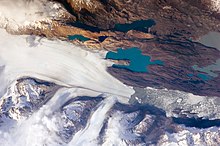Tributary glacier

A Tributärgletscher (engl. Tributary glacier , also side glacial ) is a glacier , with a larger glaciers, which main Glacier (engl. Trunk glacier ) combined. Often tributary and main glaciers have different nutrient areas . Especially in the upper part of a glacier system - - If Uniting glaciers have approximately the same size, they are also as source glaciers referred (Engl. Confluent glacier ). Tributary glaciers can in turn have other tributary glaciers, creating a tree-like glacier system.
The confluence of the glaciers, the confluence , usually affects the flow properties of both glaciers, often the main glacier is affected to some extent. Such interactions can have a significant impact on the mass balance of the glacier system.
From the point at which the tributary and main glaciers meet, the ice on these glaciers is often separated by a median moraine . This moraine, which is made up of rubble that was brought along, mostly runs in a straight line and follows the course of the glacier to the end. An exception are glacier systems in which irregular flow velocities occur periodically due to surge behavior , where the central moraines are characteristically folded.
When the ice retreats, the connection between the tributary and the main glacier can break and a glacier system can disintegrate into individual glaciers. Meltwater can accumulate at the original point of mouth and, if the ice dam suddenly ruptures, cause flooding. After they have melted, the tributary glaciers leave hanging valleys behind if they were less deeply cut than the main glacier.
literature
- Hester Jiskoot: Tributary Glaciers. In: Vijay P. Singh, Pratap Singh, Umesh K. Haritashya (Eds.): Encyclopedia of Snow, Ice and Glaciers. Springer, Dordrecht 2011, pp. 1209f, ISBN 978-90-481-2641-5